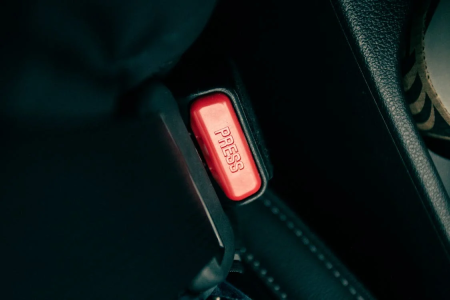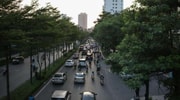Are the new seatbelt fines fair? Drivers say the system is flawed and it's costing them big
By
Maan
- Replies 0
The introduction of new technology to catch seatbelt violations in New South Wales has sparked a fierce debate among drivers and authorities alike.
What seemed like a simple safety measure has turned into a multi-million-dollar controversy, with countless drivers questioning the accuracy of the fines they're receiving.
As the number of penalties skyrockets, tensions between the public and the government are intensifying.
The New South Wales government handed out an astounding $34 million worth of fines for seatbelt violations over just six months, using new technology to catch offenders.
Since the rollout of seatbelt detection cameras on 1 July, fines for not wearing seatbelts, or wearing them incorrectly, soared dramatically across the state.
Revenue NSW’s figures revealed a shocking 1,427 per cent increase in fines from the second half of 2024 compared to the same period the previous year.
Over 70,000 fines, worth a total of $34 million, were issued from July to December 2024, compared to just 4,600 fines totalling $1.8 million in 2023.
The seatbelt violations are detected by artificial intelligence, which flags images of possible offences for human review before fines are issued.
But not everyone is convinced that the technology is foolproof.
One driver from north-west Sydney, Samantha*, found herself slapped with a fine on Christmas Day for allegedly not wearing her seatbelt correctly.
Samantha was a passenger in her husband’s car, travelling through the Southern Highlands.
She insists that the photos Revenue NSW used to justify the fine clearly show her seatbelt was on.
‘I was really cranky, I was disappointed with the system because you can clearly see in the photos that my seatbelt is on,’ she said.
The department, however, maintained that the shoulder strap of her seatbelt was under her arm.
‘It’s not true, it was kind of sitting between my shoulder and my collarbone,’ Samantha explained.
The fine came with six demerit points, double the usual three because it occurred during the holiday period.
Samantha lodged two disputes, but both were rejected by Revenue NSW.
Another driver, Seth* from Melbourne, had a similar experience.
In August, while driving through Sydney, he received a fine for his passenger allegedly not wearing his seatbelt correctly.
Seth disagreed, stating that his passenger was wearing his seatbelt properly, despite the challenges of seeing it clearly in the photos.
‘If you look at the photos provided, whilst it isn’t easy to see, both myself and my passenger are in fact wearing our seatbelts,’ he said.
His dispute was also rejected, and the matter was deemed closed.
A third driver, Nicole, from north-west Sydney, was fined while heading to Noosa with her family for Christmas.
She and her fiancé were trying to be cautious, splitting the drive over two days during the busy holiday period.
Nicole said she was shocked when she received a fine stating that her fiancé wasn’t wearing his seatbelt correctly.
The photos of the alleged offence seemed to show that her fiancé’s seatbelt had slipped slightly off his shoulder.
‘The seatbelt is on, it’s just slipped down a bit, but it’s still on his shoulder,’ Nicole said.
Despite this, the photos still led to the fine being issued.
A second photo showed the shoulder strap of the seatbelt partially obscured by the car’s frame, complicating the situation further.
Nicole, determined to dispute the fine, is ready to challenge it.
Transport for NSW’s official rules states that seatbelts should be worn across the hips with the sash across the chest and mid-shoulder.
Avinash Singh, a principal lawyer at Sydney law firm Astor Legal, said drivers had the option of contesting their fines in court.
‘In our experience as specialist criminal defence lawyers, persons who elect their fine to court are generally successful if the photos are ambiguous,’ Singh explained.
He added that unclear photos often result in fines being overturned.
‘The use of black-and-white photos for seatbelt traffic offences could sometimes be problematic, and colour photos would be better,’ he said.
Singh pointed out that colour photos would provide more clarity, especially when dark clothing makes the seatbelt difficult to see.
A spokesperson for Transport for NSW stated that all suspected seatbelt offences detected by the cameras undergo several stages of human review.
These reviews are conducted by trained personnel before fines are issued.
‘Wearing a seatbelt is a simple and highly effective way to prevent trauma, and doubles the chance of surviving a crash as well as reduces the risk of injury,’ the spokesperson said.
The spokesperson also stressed that seatbelt use was about saving lives, citing the 39 lives lost in crashes in 2024 involving passengers not wearing seatbelts.
Speaking in August, Roads Minister John Graham said the number of fines issued was unexpected.
‘We knew there was a problem with seatbelt compliance among a small section of motorists and passengers, but the reality is it is worse than expected and we need this to serve as a wake-up call,’ Graham said.
*Names have been changed.
In a previous story, we highlighted how one driver's costly seatbelt slip ended up with a hefty $1,209 fine.
To learn more about the financial impact of these violations, read the full story here.

With so many fines being issued and disputes piling up, do you think the seatbelt detection system is fair? Is it missing the mark?
Share your thoughts in the comments below!
What seemed like a simple safety measure has turned into a multi-million-dollar controversy, with countless drivers questioning the accuracy of the fines they're receiving.
As the number of penalties skyrockets, tensions between the public and the government are intensifying.
The New South Wales government handed out an astounding $34 million worth of fines for seatbelt violations over just six months, using new technology to catch offenders.
Since the rollout of seatbelt detection cameras on 1 July, fines for not wearing seatbelts, or wearing them incorrectly, soared dramatically across the state.
Revenue NSW’s figures revealed a shocking 1,427 per cent increase in fines from the second half of 2024 compared to the same period the previous year.
Over 70,000 fines, worth a total of $34 million, were issued from July to December 2024, compared to just 4,600 fines totalling $1.8 million in 2023.
The seatbelt violations are detected by artificial intelligence, which flags images of possible offences for human review before fines are issued.
But not everyone is convinced that the technology is foolproof.
One driver from north-west Sydney, Samantha*, found herself slapped with a fine on Christmas Day for allegedly not wearing her seatbelt correctly.
Samantha was a passenger in her husband’s car, travelling through the Southern Highlands.
She insists that the photos Revenue NSW used to justify the fine clearly show her seatbelt was on.
‘I was really cranky, I was disappointed with the system because you can clearly see in the photos that my seatbelt is on,’ she said.
The department, however, maintained that the shoulder strap of her seatbelt was under her arm.
‘It’s not true, it was kind of sitting between my shoulder and my collarbone,’ Samantha explained.
The fine came with six demerit points, double the usual three because it occurred during the holiday period.
Samantha lodged two disputes, but both were rejected by Revenue NSW.
Another driver, Seth* from Melbourne, had a similar experience.
In August, while driving through Sydney, he received a fine for his passenger allegedly not wearing his seatbelt correctly.
Seth disagreed, stating that his passenger was wearing his seatbelt properly, despite the challenges of seeing it clearly in the photos.
‘If you look at the photos provided, whilst it isn’t easy to see, both myself and my passenger are in fact wearing our seatbelts,’ he said.
His dispute was also rejected, and the matter was deemed closed.
A third driver, Nicole, from north-west Sydney, was fined while heading to Noosa with her family for Christmas.
She and her fiancé were trying to be cautious, splitting the drive over two days during the busy holiday period.
Nicole said she was shocked when she received a fine stating that her fiancé wasn’t wearing his seatbelt correctly.
The photos of the alleged offence seemed to show that her fiancé’s seatbelt had slipped slightly off his shoulder.
‘The seatbelt is on, it’s just slipped down a bit, but it’s still on his shoulder,’ Nicole said.
Despite this, the photos still led to the fine being issued.
A second photo showed the shoulder strap of the seatbelt partially obscured by the car’s frame, complicating the situation further.
Nicole, determined to dispute the fine, is ready to challenge it.
Transport for NSW’s official rules states that seatbelts should be worn across the hips with the sash across the chest and mid-shoulder.
Avinash Singh, a principal lawyer at Sydney law firm Astor Legal, said drivers had the option of contesting their fines in court.
‘In our experience as specialist criminal defence lawyers, persons who elect their fine to court are generally successful if the photos are ambiguous,’ Singh explained.
He added that unclear photos often result in fines being overturned.
‘The use of black-and-white photos for seatbelt traffic offences could sometimes be problematic, and colour photos would be better,’ he said.
Singh pointed out that colour photos would provide more clarity, especially when dark clothing makes the seatbelt difficult to see.
A spokesperson for Transport for NSW stated that all suspected seatbelt offences detected by the cameras undergo several stages of human review.
These reviews are conducted by trained personnel before fines are issued.
‘Wearing a seatbelt is a simple and highly effective way to prevent trauma, and doubles the chance of surviving a crash as well as reduces the risk of injury,’ the spokesperson said.
The spokesperson also stressed that seatbelt use was about saving lives, citing the 39 lives lost in crashes in 2024 involving passengers not wearing seatbelts.
Speaking in August, Roads Minister John Graham said the number of fines issued was unexpected.
‘We knew there was a problem with seatbelt compliance among a small section of motorists and passengers, but the reality is it is worse than expected and we need this to serve as a wake-up call,’ Graham said.
*Names have been changed.
In a previous story, we highlighted how one driver's costly seatbelt slip ended up with a hefty $1,209 fine.
To learn more about the financial impact of these violations, read the full story here.
Key Takeaways
- The NSW government issued over $34 million in fines for seatbelt violations between July and December 2024, marking a dramatic 1,427 per cent increase compared to the previous year.
- The fines are generated by artificial intelligence that flags images of potential violations for human review, but several drivers have disputed the accuracy of the photos used to justify the penalties.
- Drivers, including Samantha, Seth, and Nicole, argue that the photos don't clearly show violations and have had their disputes rejected by Revenue NSW.
- Transport for NSW maintains that seatbelt use is vital for safety, citing the effectiveness of seatbelts in preventing injuries, while officials say the system undergoes multiple stages of human review before fines are issued.
With so many fines being issued and disputes piling up, do you think the seatbelt detection system is fair? Is it missing the mark?
Share your thoughts in the comments below!
Last edited:








